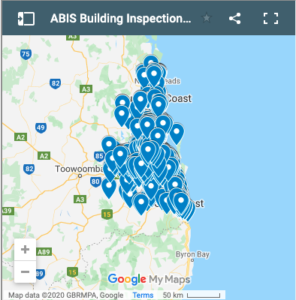Schedorhinotermes intermedius occurs coastally from southern Queensland through to New South Wales. They tend to nest in tree stumps and in the root crown area of living, dead and debilitated trees as well as in timber buried in the ground, under properties, under filled-in verandahs, and in the ground immediately under fireplaces.
This species is typified by two soldier castes: major soldiers with bulbous heads and 5 to 7.5mm and smaller minor soldiers 3 to 5.5mm with narrower heads and more slender mandibles. Both soldier types do not produce the white latex which Coptotermes acinaciformis does.
They are multi-site nesters whose nests may be difficult to locate as they are subterranean. Colonies including a queen, king, soldiers, workers and reproductives may consist of thousands of termites. The minor soldiers appear first in the developing colony, followed by the major soldiers once the nest is well established. Their abundance usually indicates a well-developed and strong colony with increasing potential for damaging timber. This species is second in economic pest status to Coptotermes spp. in most parts of Australia, with their attack taking place under the protection of extensive deposits of fragile “plastering” and excavations are fairly clean with characteristic plaster-like earthen workings separating the termites from the adjacent environment. It is very difficult to evaluate its damage to buildings without a very thorough survey of its activity.
Schedorhinotermes Summarised
Type: Subterranean
Family: Rhinotermitidae
Sub-Family: Rhinotermitinae
Genus:
- actuosus*
- breinli
- derosus
- reticulatus*
-
intermedius
Identification
Major Soldiers are 5.00 – 7.50mm and mandibulate. Major soldiers have bulbous heads
Minor Soldiers are 3.00 – 5.50 mm and mandibulate. Minor soldiers usually about two-thirds length of major soldiers. Have narrower heads and more slender mandibles. Their labrum’s extend almost to the tip of the mandibles.
Castes:
- Queen
- King
- Soldier
- Worker/reproductive
Nest Type: May nest in tree stumps, root crowns, under timber buried in the ground, under houses, under filled patios and fire places. Colonies can be very populous. Minor soldiers appear first in the developing colony, and once the nest is well established, major soldiers appear alongside the colony’s increased potential for damaging timber in service.
Significance Serious pests of wood in service: Their attack may reach the intensity of the Coptotermes species and reach their food in the same way by subterranean tunnels and shelter tubes.
Schedorhinotermes intermedius
Adult: The soldier caste of Schedorhinotermes intermedius is dimorphic with distinct forms. Major soldiers are 5-6 mm long with a bulbous head. Minor soldiers are 3-4 mm long with a smaller head. The cigar-shaped body is white and not sclerotised. Head: The head is pale to dark brown and heavily sclerotised. Mandibles of the soldier caste have teeth. A rather small fontanelle is located behind the anterior margin of the head. Antennae are bead-like (moniliform) and as long as the head. Eyes are small and maybe reduced to a small number of facets. Thorax: Adult termites generally lack wings. The primary reproductive caste has wings for the nuptial flight only. After pairing the king and queen discard their wings leaving scales. The wings of the king and queen are narrow, longer than the body and have few veins. The pronotum is flat without anterior lobes. All legs are similar in termites. The tarsi are 4-segmented. Abdomen: Subterranean termites have 2-segmented cerci at the apex of the abdomen.
Distribution: Schedorhinotermes intermedius is a commonly encountered species throughout Australia with many described sub-species.
Pest Status: This species is regarded as second to Coptotermes species in terms of economic damage. The subterranean termite does not build mounds. The species nests in tree stumps, root crown of living trees, beneath patios and beneath fireplaces. The colony can include several thousand individuals. The vitality of the nest is reflected in the number of major soldiers present.




